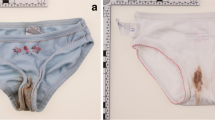Abstract
The significance of genital findings in a case of suspected child sexual abuse has been widely debated in the past decades, as shown by the different classifications available in literature. In the case of postmortem examination, the search for signs of sexual abuse is considerably more difficult because of the superimposition of postmortem modifications, which may determine tissue modifications that can be mistaken for traumatic lesions. This study aims at reporting a case where presumed findings of the first autopsy were denied by histological analysis; in detail, what looked like a possible bruise of the hymen was correctly recognized as hypostasis (livor) of the hymenal tissue by histological analysis. This case report suggests caution in the analysis and discussion of genital lesions found during postmortem examination since the superimposition of cadaveric modifications may radically modify the morphology of soft tissues.




Similar content being viewed by others
References
Hobbs CJ (2012) Physical evidence of child sexual abuse. Eur J Pediatr 171(5):751–755
Adams JA (2008) Guidelines for medical care of children evaluated for suspected sexual abuse: an update for 2008. Curr Opin Obstet Gynaecol 20:435–441
Adams JA (2011) Medical evaluation of suspected child sexual abuse: 2011 update. J Child Sex Abus 20:588–605
Royal College of Physicians (1997) Physical signs of sexual abuse in children, 2nd edn. Royal College of Physicians of London, London
Adams JA, Harper K, Knudson S, Revilla J (1994) Examination findings in legally confirmed child sexual abuse: it’s normal to be normal. Pediatrics 94:310–317
Elder DE (2007) Interpretation of anogenital findings in the living child: implications for the paediatric forensic autopsy. J Forensic Legal Med 14:482–488
Taborelli A, Andreola S, Di Giancamillo A, Gentile G, Domeneghini C, Grandi M, Cattaneo C (2011) The use of the anti-Glycophorin A antibody in the detection of red blood cell residues in human soft tissue lesions decomposed in air and water: a pilot study. Med Sci Law 51(Suppl 1):S16–S19
Kibayashi K, Hamada K, Honjyo K, Tsunenari S (1993) Differentiation between bruises and putrefactive discolorations of the skin by immunological analysis of glycophorin A. Forensic Sci Int 61:111–117
Tabata N, Morita M (1997) Immunohistochemical demonstration of bleeding in decomposed bodies by using anti-glycophorin A monoclonal antibody. Forensic Sci Int 87:1–8
Wheater P, Burkitt G, Stevens A, Lowe J (1996) Wheater’s basic histopathology: a colour atlas and text, 3rd edn. Pearson Professional Limited, London
Khasnis A, Gokula RM (2002) Spider nevus. J Postgrad Med 48(4):307–309
Finn SM, Rowland M, Lawlor F, Kinsella W et al (2006) The significance of cutaneous spider naevi in children. Arch Dis Child 91(7):604–605
Requena L, Sangueza OP (1997) Cutaneous vascular anomalies. Part I. Hamartomas, malformations and dilation of pre-existing vessels. J Am Acad Dermatol 37(4):523–549
Cotran RS, Kumar V, Collins T (1999) Pathological bases of disease, 6th edn. W. B. Saunders Company, Philadelphia
Spitz WU (2006) Medico-legal investigation of death, 4th edn. Charles C Thomas, Springfield
Saukko P, Knight B (2006) Forensic pathology, 3rd edn. Arnold Ed, London
Pollanen MS (2012) Forensic pathology and the miscarriage of justice. Forensic Sci Med Pathol 8:285–289
McCann J, Reay D, Siebert J, Stephens BG, Wirtz S (1996) Postmortem perianal findings in children. Am J Forensic Med Pathol 17:289–298
Anderst J, Kellogg N, Jung I (2009) Reports of repetitive penile–genital penetration often have no definitive evidence of penetration. Pediatrics 124:e403–e409
Kellogg ND, Parra JM, Menard S (1998) Children with anogenital symptoms and signs referred for sexual abuse evaluations. Arch Pediatr Adolesc Med 152:634–641
Lawson Z, Nuttall D, Young S, Evans S, Maguire S, Dunstan F, Kemp AM (2011) Which is the preferred image modality for paediatricians when assessing photographs of bruises in children? Int J Legal Med 125:825–830
Fracasso T, Pfeiffer H, Sauerland C, Schmeling A (2011) Morphological identification of right ventricular failure in cases of fatal pulmonary thromboembolism. Int J Legal Med 125:45–50
Author information
Authors and Affiliations
Corresponding author
Rights and permissions
About this article
Cite this article
Ambrosetti, F., Palazzo, E., Gibelli, D. et al. The risk of misinterpreting genital signs of sexual abuse in cadavers: a case report. Int J Legal Med 127, 907–910 (2013). https://doi.org/10.1007/s00414-013-0891-y
Received:
Accepted:
Published:
Issue Date:
DOI: https://doi.org/10.1007/s00414-013-0891-y




